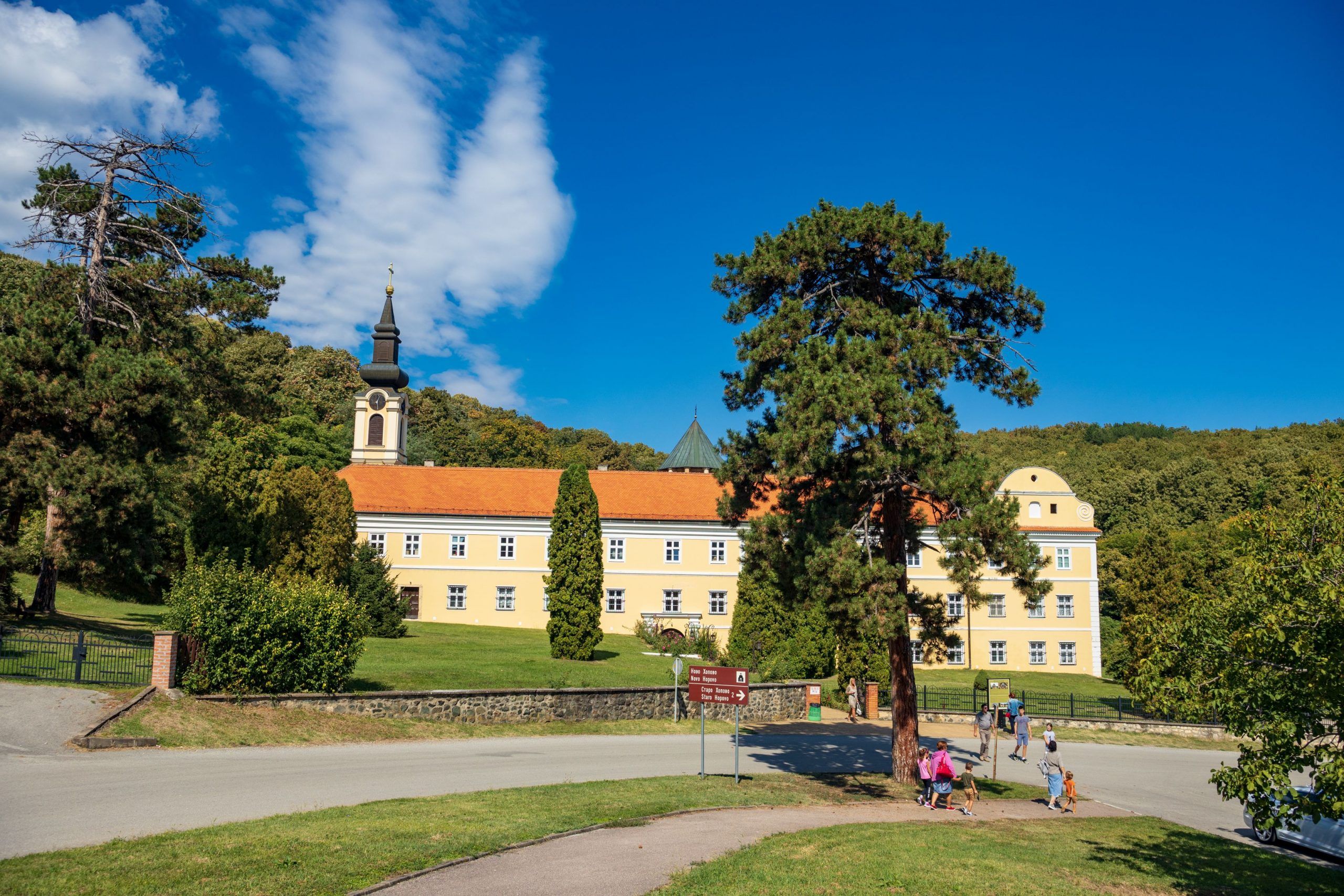Irig – Mala Remeta – Rivica – Neradin
Tourist attractions of the Irig area, which consist of cultural monuments of exceptional value – Serbian Orthodox monasteries of Krušedol, Novo Hopovo, Staro Hopovo, Vrdnička Ravanica, Velika Remeta, Mala Remeta, Grgeteg and Jazak, natural values including Banja Vrdnik, the lakes Međeš, Dobrodol and Borkovac, a protected area within the National Park “Fruška Gora”, numerous picnic areas, marked walking trails, viewpoints, Perkov’s “salaš” farmstead, Ethno Village “Vrdnička Kula” … are the basis on which the tourist product of the area is founded. In recent decades, wine and the offer of wine houses and rural wine households have increasingly become that part of the tourist offer that attracts the majority of visitors to the Irig area.
Irig, Rivica, Mala Remeta and Neradin are more clearly profiled as wine centres because on the Irig slopes of Fruška Gora, in addition to cultivating the old ones, new vineyards are now being intensively grown in which the following assortment of grapes[1] is cultivated: Chardonnay, Sauvignon Blanc, Rhine and Italian Riesling, Pinot Gris, Neoplanta, Traminer, White and Red Tamjanika, Morava, Slankamenka, Gewurztraminer, Cabernet Sauvignon, Merlot, Pinot Noir, Vranac, Probus, Prokupac, Portuguiser, Marselan, Cabernet Franc, Petit Verdot and Muscat Hamburg, etc. In honour of grape and wine, the following events are held every year: Pudarski dani (Days of Vineyard Keepers), Dan mladog Protugizera (Young Portuguiser Day) in Irig and Dani vina (Wine Days) in Rivica, where winemakers and wine lovers gather, the first to evaluate wines and exchange experiences, and the second to enjoy the fruits of their work and skills.
Irig is first mentioned in historical sources in 1225, and the legend says that it was an important centre in the 15th and 16th centuries when Serbian despots, including Zmaj Ognjeni Vuk, ruled in Srem. The economic power of the place grew starting from the middle of the 18th century, first on the basis of the imperial privilege which gave the right to collect income from as many as two fairs a year, and then on vineyards and fruit orchards. At the beginning of the 18th century, Irig had the status of the centre of Serbs in Srem and the “capital of Fruška Gora”, so it is quite clear why the oldest Serbian reading club – the Serbian Reading Room was founded there (1842). Also, out of sixteen Fruška Gora monasteries, erected in the period from the 15th to the 18th century, eight were built in the territory of the Irig Commune (Krušedol, Novo Hopovo, Staro Hopovo, Vrdnička Ravanica, Velika Remeta, Mala Remeta, Grgeteg and Jazak).
For the needs of their own growing community (in both the number and economic wealth) the Serbs built three Orthodox churches in the centre of Irig: the Church of the Assumption of the Mother of God (18th century), Church of St. Theodore Tyrone (18th century) and the Church of St. Nicholas (18th century). The Roman Catholic parish Church of All Saints was built in the 19th century. And who knows how Irig would have been developing further if there had not been the plague in Srem, which is 1795/6 halved the population of Irig and the invasion of phylloxera at the end of the 19th century, which destroyed Irig vineyards. The production of Irig wines began to recover significantly after the World War I, which is shown by the founding of Iriški podrum (Irig Wine Cellar) in 1930, and the tradition of famous Irig wines producing is continued today by Kovačević Winery, Mačkov Podrum Winery and Krstašica Winery (Irig).
Mala Remeta, a village near Irig, was first known for the monastery of the same name, which legend says was given to the Rača monastery by the Serbian king Dragutin Nemanjić (1276-1316) as a convent. Historical sources record that it was destroyed during the Turkish rule of Srem and that it was rebuilt in the 17th century. The modern monastery church, dedicated to the Intercession (Protection) of the Holly Mother, was built in the first half of the 18th century. Today, it is one of the most visited monasteries at Fruška Gora. Nearby there is the Restaurant with accommodation “Fruškogorska lugarnica” a place that offers interesting content of the stay. Contemporary tourists are increasingly looking for enjoyment in wines, gastronomy, peace and healing properties of preserved nature, and that is the experience offered by Deurić Winery.
Rivica is an old settlement that can document the continuity of existence since the 12th century. Cultural monuments that include the Church of St. George from the first half of the 18th century and the mill older than the church still testify to bygone times. The place is on the map of wine trails thanks to Odrovački Winery at the place itself and Komuna Winery in the area of Rivica, right next to the Lake Borkovac.
Neradin is a small village in the Irig municipality where the Church of St. Nicholas from the first half of the 18th century, with the iconostasis of great value, probably the work of Vasilije Ostojić and his assistant Jovan Popović is located. Neradin entered the tourist map of Serbia thanks to Perkov’s “salaš” farmstead, which offers guests an authentic view of the farm life of the past, which can be tasted, touched and carried as a fond memory. In recent years, the tourist offer of Neradin has been enriched by Tadić Winery, a place that welcomes guests and offers excellent wines.
For more information about Irig and surroundings visit: http://www.turorgirig.org.rs/
Text: Gordana Stojaković
Photographs: Aleksandar Milutinović
Tourism Organisation of the City of Novi Sad is not responsible for changes in information and services.
The text posted in: October 2021
[1] Transcription of the grape assortment names is given according to: Cindrić, Petar and Vladimir Kovač (2007) “Vinogradarstvo i vina“ (“Viticulture and Wines“) Fruška Gora. Ed. Nebojša Jovanović and Jelica Nedić. Pg. 498. Beograd: Zavod za udžbenike.



